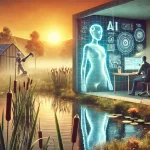
Democratizing Creativity: How AI Tools Are Empowering Non-Technical Professionals in 2025
The creative landscape is undergoing a significant transformation as artificial intelligence becomes increasingly accessible to professionals without technical backgrounds. What was once the domain of engineers and computer scientists is now available to marketers, designers, content creators, and other non-technical professionals who can harness these powerful tools with minimal technical expertise.
The Democratization of Creative AI
The most striking development in 2025’s AI landscape is how these sophisticated technologies have become accessible to virtually anyone. According to research from ProfileTree, 85% of the jobs that will exist in 2030 haven’t been invented yet, highlighting the rapid evolution of roles that incorporate AI skills across all professional categories, not just technical ones. This democratization is happening through several key developments:
Low-Code and No-Code Platforms
No-code machine learning platforms like Obviously AI and MindsDB now allow users to create and deploy models without any programming knowledge, as reported by ITtech-pulse. These platforms use intuitive graphical interfaces and pre-built modules that empower users with limited or no programming expertise to build, train, and deploy AI models.
Voice Control Integration
Voice control integration with AI has further democratized creative tools by enabling individuals who may struggle with text-based interfaces to create content more easily. According to GetNoan, this technology is opening up new avenues for creative productivity, making it accessible to a broader audience including those with disabilities or different working styles.
AI Adoption Statistics Among Non-Technical Professionals
The adoption of AI among non-technical professionals is accelerating rapidly. Current statistics paint a clear picture of this trend:
- 77% of businesses are now adopting AI across all sectors, according to Apollo Technical
- 58% of businesses will increase AI investments in 2025, with average budget increases of 32%, as reported by ProfileTree
- Despite growing adoption, only 16% of workers currently use AI for some tasks, though 25% believe their work could be performed with AI, especially among those under 50, suggesting significant room for growth
Interestingly, there’s a mixed sentiment about AI’s impact on jobs and work. While 52% of U.S. workers are worried about AI’s future impact, with 32% believing it will reduce job opportunities, 36% of workers are hopeful about AI’s impact, particularly younger workers and those with higher education.
Most Popular AI Tools for Non-Technical Creative Professionals
Design and Graphic Design Tools
-
Adobe Firefly
This generative AI tool integrated into Photoshop and Illustrator allows users to generate images and design elements using simple text prompts. According to Futurense, it ensures copyright-safe outputs and offers features like text effects and AI-assisted recoloring.
Adobe’s development of Firefly represents a groundbreaking example of AI integration in creative tools. As SingleGrain reports, this all-in-one AI creative suite unifies AI content creation across Adobe’s Creative Cloud, enabling seamless integration across devices. -
Canva Magic Studio
AI-powered design platform that offers features like Magic Write for content creation, Magic Edit for images, and Magic Design for layout suggestions, starting at $12.99/month for premium plans, according to DevTechnosys. -
Autodraw
A free AI tool developed by Google that turns simple doodles into professional-looking drawings, ideal for quick ideations and prototyping, as noted by Filestage.
Content Creation Tools
-
Jasper AI
A generative AI tool for marketing, copywriting, and SEO tasks that allows users to generate high-converting content using customized templates and brand voices, as reported by Futurense. -
ChatGPT
According to 7Tech, ChatGPT acts as a versatile assistant for tasks like summarizing documents, drafting content, and offering conversational support for brainstorming sessions, helping creative professionals refine ideas and produce drafts quickly.
Productivity Tools
-
Microsoft Copilot
Integrates with Microsoft 365 applications to help with tasks like drafting emails, summarizing meetings, and creating presentations. At approximately $30 per user per month, it often justifies the cost through time saved and improved output quality, according to 7Tech. -
Notion AI
A powerful tool that integrates into the Notion platform, offering AI-powered content generation, task management, and project management. According to TheMexpert, it helps users quickly capture ideas, organize thoughts, and create structured documents with smart recommendations.
Barriers to AI Adoption for Non-Technical Professionals
1. Skills and Cultural Resistance
According to Pariveda Solutions, non-technical professionals often lack the necessary expertise to effectively use AI tools, and cultural resistance can be significant. Employees may fear job obsolescence or significant role changes.
2. Social Stigma and Trust Issues
A Duke University study featured on eWeek found that the use of AI can lead to social stigma in the workplace, where individuals who rely on AI tools may be judged more harshly by their peers. This can discourage AI adoption if employees fear social penalty.
3. Value Realization and Measurement
Demonstrating tangible business value from AI investments remains a challenge. Leaders struggle to justify AI investments without clear bottom-line impact, making it difficult for non-technical professionals to advocate for AI adoption in their departments.
Essential Skills for Non-Technical Professionals Using AI
1. AI Literacy and Tool Literacy
AI Literacy is becoming a must-have skill across industries. According to MLNotes, it involves understanding the basics of AI, how it is used, and its limitations. AI Tool Literacy involves the ability to select and use appropriate AI tools for specific creative tasks.
2. Prompt Engineering
As highlighted by Penn Career Services, prompt engineering is the skill of effectively “talking” to AI tools so they produce the desired output. It requires understanding how to create clear, concise, and relevant input for AI models.
3. Critical Thinking with an AI Twist
Critical thinking in the context of AI involves evaluating AI-generated content for accuracy, ethical implications, and potential biases. This skill helps creative professionals ensure that the AI outputs align with their vision and meet quality standards.
4. Data Fluency
Data fluency involves understanding how data informs AI decisions. While it doesn’t require becoming a data scientist, creative professionals should be able to interpret data and make informed decisions based on AI outputs.
Ethical Considerations for Creative AI Use
1. Bias and Fairness
AI systems can perpetuate biases present in the data they are trained on, which can lead to unfair or discriminatory creative content. As noted in research from Leon Furze, creative professionals need to be aware of these biases and take steps to mitigate them.
2. Copyright and Intellectual Property
According to Anthem Creation, AI tools are often trained on existing creative works, raising questions about the recognition and remuneration of original creators. This can lead to legal and ethical challenges regarding intellectual property rights.
3. Quality and Aesthetic Considerations
The use of AI can lead to “hallucination” phenomena where AI invents or distorts information, which can result in a lack of reliability in creative output. Additionally, there’s a risk of standardizing styles and impoverishing creative diversity, as AI might produce similar results that lack the uniqueness of human creativity.
Success Stories: AI in Creative Work
Hargreaves Lansdown and Microsoft 365 Copilot
As reported by Microsoft, Hargreaves Lansdown used Microsoft 365 Copilot to enhance accessibility and productivity. This AI assistant helps in tasks that can be particularly time-consuming for non-technical users, saving an employee with dyslexia approximately four hours a day.
HoMie and Microsoft 365 Copilot
HoMie, a social enterprise, used Copilot to become more efficient in creating products, allowing more time and money to be spent on social impact programs. This case study demonstrates how AI can help non-technical professionals in creative and social impact areas by reducing the time spent on repetitive tasks.
How Small Businesses and Freelancers Use AI
1. Generative AI for Content Creation
According to Squarespace, many small businesses use generative AI models to create text, images, videos, and other media content efficiently. Freelancers in digital design use AI-powered tools to produce logos, social media content, websites, and branding materials that maintain a human feel while benefiting from automation.
2. No-Code/Low-Code AI Tools for Website Building
AI-driven website builders like 10Web enable freelancers and small business owners to launch professional websites quickly without coding skills. As reported by 10Web, these platforms often include integrated e-commerce capabilities allowing entrepreneurs to run online boutiques with print-on-demand designs or curated product lines easily.
3. Enhanced Marketing Through AI Automation
AI marketing tools are widely adopted by small businesses in 2025 to optimize campaigns with data-driven insights, automate customer engagement processes, personalize outreach at scale, and measure key performance metrics effectively, as noted by Nimbata.
The Future of AI for Non-Technical Professionals
Looking ahead, several trends will continue to shape how non-technical professionals use AI in creative work:
Personalized AI Assistants
Emerging trends include the development of personalized AI assistants that learn specific user styles and preferences, making them even more useful for creative professionals with unique needs and workflows.
Immersive Design for AR/VR
AI tools are increasingly being used to create immersive experiences in augmented and virtual reality, opening up new creative possibilities for non-technical professionals in fields like marketing, education, and entertainment.
Unified Creative Suites
The integration of multiple AI tools into unified creative suites will enhance workflow efficiency, making it easier for non-technical professionals to move seamlessly between different creative tasks without having to learn multiple interfaces.
Conclusion: Embracing AI as a Creative Partner
As AI tools become more accessible and user-friendly, non-technical professionals have an unprecedented opportunity to enhance their creative work. By developing the right skills, understanding the ethical implications, and choosing the appropriate tools, these professionals can leverage AI as a powerful creative partner rather than viewing it as a technical challenge or a threat to their jobs.
The democratization of AI is not just about making technology more accessible; it’s about empowering a broader range of voices and perspectives in the creative process. As we move forward, the most successful creative professionals will be those who can effectively collaborate with AI, using it to augment their unique human creativity rather than replace it.
Have you incorporated AI tools into your creative workflow? Share your experiences and insights in the comments below, and let us know which tools have been most helpful for your non-technical creative work.
Further Reading:
- The Ethics of AI in Creative Industries
- AI Tools for UX/UI Designers in 2025
- Top AI Productivity Tools You Need in 2025


